Ryan Shay Tribute: Notre Dame Mourns The Death Of A Champion – Nov. 4, 2007 By Pete LaFleur
Former Notre Dame standout distance runner Ryan Shay – who helped revolutionize the sport of marathon running in recent years – died suddenly on the morning of Saturday, Nov. 3, while competing at the 2008 U.S. Olympic marathon trials in New York City. Shay had been a nine-time All-American and also was an Academic All-America honoree at Notre Dame before making an impressive transition to the marathon distance, immediately following his graduation in 2002.
“Ryan was here just last week at our practice, before he headed out to New York for the trials,” says Joe Piane, who recently embarked on his 33rd season as head coach of the Notre Dame men’s cross country team and the school’s track-and-field programs. “All the kids on the current team know who he is – he’s an inspiration to them.”
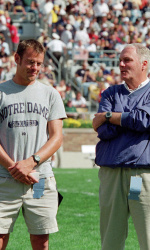
Joe Piane (right) joined Ryan Shay on the field during a 2001 Notre Dame home football game, as Shay was recognized by 80,000-plus fans for his NCAA championship in the 10,000 meters during the previous spring season (photo by Mike Bennett).
“I can’t imagine what Ryan’s family is going through right now. As a father myself, I shared this news with my young son. He had become very close with Ryan over the years and he is devastated, as is everyone who knew Ryan. He had been running extremely well and training great. He was a picture of health.”
The following arrangements for Shay have been announced: Visitation – Mortensen Funeral Home in Central Lake, Mich. (Central Lake Chapel), Friday, Nov. 9 (5:00-8:00 p.m.) and Saturday, Nov. 10 (noon-8:00 p.m.), details at www.mortensenfuneralhomes.com; Funeral (Sunday, Nov. 11) – Harvest Barn Church in East Jordan, Mich., visitation from 1:00-2:00 p.m., service at 2:00 p.m. … Memorials – Contributions to The Ryan Shay Memorial Fund may be sent to 5873 Leisure Lane, East Jordan, MI 49727 … Hotel Reservations – bereavement rates are available at Shanty Creek Resort (231-533-8621).
The 28-year-old Shay – who was married earlier this year to former Stanford elite distance runner Alicia Craig – became the first Notre Dame student-athlete ever to be a seven-time All-American and later pushed that total to nine, during the 2002 NCAA track competition. That accomplishment was eclipsed last spring, when fellow distance runner Molly Huddle earned the 10th All-America finish of her Notre Dame career. Shay’s teammate and former roommate Luke Watson nearly had matched his record in 2003, as Watson finished his own Notre Dame career as an eight-time All-American in various distance races.
“The hardest thing to do as a coach was hold Ryan back,” says Piane. “He also was a great leader and team captain. He would not stand for anyone else on the team running poorly.
“There was more to Ryan than just his running ability and competitiveness. He was a great leader and a tremendous student, as an Academic All-American. He was the whole package.”
Shay’s nine All-America honors included four in the outdoor 10,000 meters, two in the indoor 5K, two in cross country, and one in the outdoor 5K. The Central Lake, Mich., native returned for a fifth year of eligibility in 2001-02, after previously missing one cross country season (in 2000) and one track season (’98) due to injuries. He still holds Notre Dame records in two events – the outdoor 10,000 meters (28:25) and indoor 5K (13:46) – while his Notre Dame record in the outdoor 5K was broken by Watson in 2003 (13:38; since broken by Kurt Benninger’s 13:33 in 2005). Shay graduated from Notre Dame in 2002 with a 3.21 cumulative grade-point average, as a double major in economics and computer applications.
His postgraduate training had included ramping up to the marathon distance, more than four times the length of a 10K. Shay won the 2003 U.S. Marathon race – becoming that event’s youngest champion in 30 years – and was among the favorites heading into the 2004 Olympic trials, before being slowed by a hamstring strain and finishing 23rd at that race in Birmingham, Ala. (2:19:20).. He also recently had won U.S. titles in the 15K (’05), 20K (’04) and half-marathon (’03, ’04) races.
Shay was the fifth-oldest of eight children who all became competitive distance runners. His parents Joe and Susan had no background in running before their children took up the sport – but the Shay parents now are the cross country and track-and-field coaches at their hometown Central Lake High School.
 Ryan Shay’s first-place finish in the 2001 NCAA 10,000-meter race represented Notre Dame’s first national championship in an outdoor track-and-field event in nearly 50 years (photo by NCAA photos).
Ryan Shay’s first-place finish in the 2001 NCAA 10,000-meter race represented Notre Dame’s first national championship in an outdoor track-and-field event in nearly 50 years (photo by NCAA photos).
A moment of silence was observed for Shay before Notre Dame athletic events on campus this weekend, including the football game versus Navy. Six years earlier, Shay was honored on the field at Notre Dame Stadium during a 2001 Irish football game – as more than 80,000 fans applauded in recognition of his NCAA 10K championship that had been won during the previous spring season.
Huddle and Watson – a two-time Academic All-American who also was a standout racer in the mile – fashioned their own stellar careers as members of the Notre Dame cross country and track-and-field teams, but neither of them ever won an NCAA individual title. Such was the accomplishment for Shay at the 2001 NCAA 10,000-meter race, when he torched the competition to win in a time of 29:05 (more than 20 seconds ahead of the runner-up, Murray Link of Arkansas). He became Notre Dame’s first NCAA track-and-field champion since 1972, when Tom McMahon won the NCAA 55-meter indoor high hurdles.
One had to go all the way back to 1956 – when Aubrey Lewis won the 400-meter hurdles – to find Notre Dame’s previous NCAA champion at the outdoor meet. Lewis won his NCAA title 23 years before Shay was born (March 6, 1979, in Ann Arbor, Mich.).
“Leading up to the 2001 NCAA 10,000-meter race, we knew that Ryan would be one of the top contenders and frankly thought he had what it took to win the race,” recalls Piane. “He took the lead after the first lap and then led for the final 24 laps. He just dominated the field that day and won going away. He was tenacious.”
To put Shay’s NCAA title into further perspective, his championship is one of only eight in Notre Dame history (the first since 1944) to come during an NCAA running event and five of those NCAA titles came at the shorter distances of 600 yards, one mile or two miles (3). The only previous Notre Dame competitors ever to win an NCAA title in an event longer than two miles were Greg Rice (in 1938) and Oliver Hunter (in 1942) at the NCAA cross country meet, which was a four-mile race (2,500 meters) during that era.
Notre Dame’s only other NCAA champions in running events have been Charles Judge in the 1926 mile, Rice in the 1937 and ’39 NCAA two-mile races, Frank Martin in the 1944 two-mile, and Rick Wohlhuter in the 600-yard race at the 1970 NCAAs. Rice’s stellar career included receiving the Sullivan Award, as the nation’s premier amateur athlete.
Shay fittingly had grown up idolizing runner Steve Prefontaine, a native of the pacific Northwest who ran collegiately at the University of Oregon. So when he learned that the 2001 NCAA outdoor meet was going to held in Eugene, Ore. – on the track where Prefontaine gained his fame – Shay gained an extra dose of motivation.
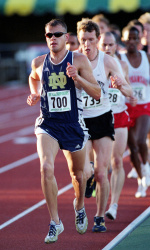 Shay was in the front of an early pack during the 2001 NCAA 10K – but he soon pushed the pace and went on to win by a 20-second margin (photo by NCAA photos).
Shay was in the front of an early pack during the 2001 NCAA 10K – but he soon pushed the pace and went on to win by a 20-second margin (photo by NCAA photos).
“If I was going to win, that’s where I wanted to do it,” recalled Shay, who even had a series of articles about Prefontaine taped to his bedroom walls.
Shay, who entered the 2001 NCAA 10-K race as the #4 seed, made a bold move early in that elite race. After sitting back through the first lap, he decided to take the initiative by picking up the pace.
“I told myself that it was going to be a 10-K race from the start,” Shay later said. “Anybody who wanted to go out slow, this wasn’t going to be the race for them. I’ve learned from experience not to be content to sit back and take it slow. So I kind of forced the issue.”
By the time Shay reached the halfway mark, the race had become a two-man battle between himself and Link. With three laps to go, Shay’s lead was so large that only a fall could prevent his historic championship-winning performance. But top seed Keith Kelly of Providence College, the reigning NCAA cross country champion, had developed a reputation for being a strong closer who could erase seemingly insurmountable leads
“I kept waiting to hear his footsteps, but they never came,” said Shay, who finished a whopping 46 seconds ahead of the favored Kelly.
Shay left his own footsteps on the sport of marathon racing, after making the rare jump from being a premier collegiate distance runner to becoming one of the nation’s top competitors at the grueling 26-mile distance.
“Ryan was one of the first guys who came straight out of college and said, `I want to run a great marathon.’ Some who have gone from college running to the marathon did not excel on the track during their college career like Ryan did,” says Watson, who currently serves as a member of the cross country and track-and-field coaching staffs at Notre Dame.
“During Ryan’s first season as a professional, he won the U.S. Marathon. For a newcomer to make that quick of a jump from college to being an elite marathoner was revolutionary. Now people are doing it more regularly, including Ryan Hall [who concluded his career at Stanford in 2005 and won Saturday’s 2007 Olympic marathon qualifier]. If not for Ryan Shay, I don’t think it would have been as easy for others to make the jump from running 10-Ks to marathons.”
Hall – who never had run a marathon before April of this year – followed Shay’s lead in making the quick transition to the longer distance. Hall’s eighth-place finish at that first marathon (in London, versus an elite field) produced the fastest marathon debut ever by an American.
Shay and Hall recently had been training partners near Hall’s college stomping grounds in Woodside, Calif. (near Palo Alto). But the Shay-Hall connection has yet another layer, as their wives – both Olympic hopefuls in the 10,000 meters – were teammates at Stanford and are close friends. Just four months ago, Sara (Bei) Hall served as a bridesmaid at Ryan and Alicia Shay’s wedding in Jackson Hole, Wyo. – and the two couples went on a “fun run” through Central Park last Friday, the day before the Olympic trials.
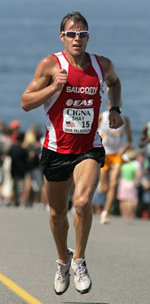 Shay’s quick transition from being an elite college distance runner to emering as one of the nation’s top young marathoners made him a revolutionary in the world of competititve running.
Shay’s quick transition from being an elite college distance runner to emering as one of the nation’s top young marathoners made him a revolutionary in the world of competititve running.
Hall did not hear of Shay’s death until he had crossed the finish line as the champion of the Olympic trials. “That just cut me straight to the heart,” said Hall, who now is dedicating his race at the Olympics to Shay. “It makes you forget what you just did.
“[Ryan was] a workhorse,” Hall added. “Nobody ran harder than him. He had a lot of passion. I’ll be thinking of him when I’m out there training. He was inspiring to be around.”
For those not familiar with the demands required for running different distances, making the shift from 10-K races to marathons provides a significant shock to the system. Individuals – like Shay – who can excel at both distances are few and far between.
“In 10-K races, you have to battle lactic acid buildup over a significant time. But in marathons, it’s totally different because your body is running out of fuel,” explains Watson. “You aren’t getting that `quick burn’ like you would in sprints, weightlifting or 10-Ks. Instead, you are fighting your body, which does not want to continue. But Ryan was able to make that transition and did so with great success.”
Shay’s decision to pursue the marathon route sent him on an initial cross-country drive from his native northern Michigan to the Sierra Nevada Mountains and the town of Mammoth Springs, Calif. It was there that he trained under legendary coach Joe Vigil while running alongside Olympians such as Meb Keflezighi (the 2004 Olympic silver medalist) Nick Rogers, Deena Drossin Kastor (’04 Olympic bronze), Jen Rhines and Amy Rudolph. Former marathon all-stars Terrence Mahon and Peter DeLaCerd, plus 5K/10K specialist Matt Downin, also were among the assembled talent that was brought together during the fall of 2002 by the association that was known then as Team Running USA Southern California.
The experience in Mammoth Springs was conveyed by Shay in an online journal. Proclaiming that he was taking his “good old fashioned Midwest values and work ethic” and looking to “plant them in new soil,” Shay settled in at the high-elevation, oxygen-deprived environment. It did not take long for Vigil’s coaching methods to make an impact on the bright-eyed marathon newcomer.
“I was absolutely impressed with his ability to motivate and his abundant knowledge of the science, physiology and philosophy of the sport,” said Shay, in the online journal. “Coach Vigil possesses the tough-love mentality that I was looking for in a coach.”
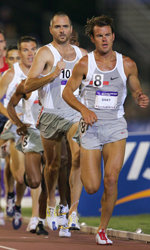
Shay ‘s time of 2:14:58 was good for a third-place finish in the 2006 Twin Cities Marathon (photo by Getty Images).
Shay also received valuable mentoring from the other members of that training group and soon he was running in his first 26-mile race, at the 2002 LaSalle Bank Chicago Marathon. One year later, Shay ran to victory at the USATF National Championship Marathon in Birmingham, Ala., breaking the tape in a time of 2:14:29. His seven career marathon finishes included three others in the same time range, among them a ninth-place finish in the 2004 New York City Marathon (2:14:08) and a third-place showing in the 2006 Twin Cities Marathon (2:14:58). Keflezighi was the only American to finish higher than Shay at the 2004 NYC Marathon.
One year later in New York, Shay had a disappointing 18th-place finish. But it was there that he met Craig, a former two-time NCAA champion in the 10,000 meters who also set the NCAA 10-K record (32:19) during her Stanford career. The future husband and wife began dating a few months later. “They hit it off right away,” says Sara Hall. “They were inseparable.”
Shay spent the fall of 2005 training in the Palo Alto area alongside a collection of young distance-running talent namely Ian Dobson, Ryan and Sarah Hall, Gabe Jennings, Lauren Fleshman, Kate and Laura O’Neil, Missy Buttry, and his future wife Alicia Craig. Shay and his bride-to-be briefly lived in Denver during early 2006 before deciding to settle in Flagstaff, Ariz. He spent the five months leading up to the trials training alongside top talent Abdi Abdirahman, who joined Shay in taking advantage of the 7,000-foot altitude, great running trails and the nearby High Altitude Training Center at Northern Arizona University. Shay maintained his steady progress and headed into the 2007 trials as a contender to make the three-man Olympic team.
“I thought [Saturday] would be his day,” said Keflizighi, after receiving the tragic news of Shay’s death. “[Ryan] had trained very, very hard to make a breakthrough. He’d lost a lot of weight and was ready to go. I really thought that today he was going to have a breakthrough, because he likes it when it’s windy and cool. … He was a great training partner but – more than that – he was a great friend”
According to Watson, Shay had been planning to make a return to 10-K racing in the near future.
“Ryan still was a great 10-K runner during the past few years,” says Watson “In the spring of 2006, he ran a 10K at Stanford in 28:04. That’s 22 seconds below the Notre Dame record he set and any time around 28 minutes is almost world-class. He always was driven by trying to run that race under 28 minutes.
“He could have been an Olympic-caliber runner in the 10,000 meters after graduating from Notre Dame, but – true to his character – he took the bigger challenge of making that the uncharted transition to the marathon. Ryan always had run on roads and was well-suited for the marathon, because he was a high-mileage and fast-pace runner every day. When training at altitude, Ryan had a great response. There never was an off-day for Ryan.”
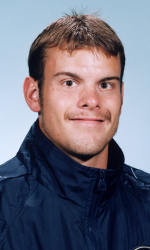 Shay recently had married former Stanford standout Alicia Craig, a 2008 Olympic hopeful in the 10,000 meters.
Shay recently had married former Stanford standout Alicia Craig, a 2008 Olympic hopeful in the 10,000 meters.
Ryan and Alicia Shay had emerged as one of the top couples in professional distance running, a close-knit community that still was coming to grips with Ryan’s death when the NYC Marathon began earlier today. Just two months ago, the couple posted top times at the U.S. 20-K Championship in New Haven, Conn., with Alicia winning her race (1:06:56) while Ryan was fifth in the men’s standings (1:01:21).
“I saw a soft side of [Ryan] with Alicia,” said Sara Hall, in a recent interview. “You could just tell his love for her. That was a side I got to know more.”
Watson likewise saw a positive impact on Shay following his marriage.
“I was very impressed and happy when Ryan found someone who was his equal intellectually,” says Watson. “Alicia has great running talents as well, but she also wasn’t afraid to debate things with Ryan. And he loved that. It brought out a great side of Ryan.”
Shay also spoke of the couple’s relationship in recent articles, saying, “Running is my career. It’s 24/7. Every decision you make will affect your performance. It’s hard to find someone who respects that, but Alicia and I are very supportive of each other.”
 Roommates Luke Watson (left) and Ryan Shay (right) were a formidable pair on the cross country trails during their Notre Dame careers (photo by Matt Cashore).
Roommates Luke Watson (left) and Ryan Shay (right) were a formidable pair on the cross country trails during their Notre Dame careers (photo by Matt Cashore).
In the hours following Shay’s death, Watson had the chance to talk to some of his roommate’s former teammates and close friends. Several “classic Ryan Shay” stories were dredged up – and many of them had nothing to do with running.
Watson recalled one year when he made a fateful five-hour drive with Shay to his hometown in northern Michigan. Shay’s “old, beat-up” Saturn S-10 broke down halfway through the voyage, stranding the teammates at midnight in a small, sleepy town.
“We were stuck in this town with nothing to do, waiting for Ryan’s dad to come get us,” remembers Watson. “So we went to this grocery store, which was the only place open, and bought some sandwiches and fireworks. We had to kill some time, so we had shopping-cart races in the parking lot and shot off fireworks while we waited.
“Some people who may not have known Ryan that well might assume that he would have flipped out in that situation. But he had a side of him away from running – he liked to relax and just have fun, to the point of being slaphappy. He made the best out of a frustrating situation – it was really cool to see that from him.”
The former roommates recently had another meaningful adventure while offroading in Shay’s new pickup, out in California. At one point, they came to an end of a road and faced what they thought was a small hill. Opting to make what appeared to be a 20-minute climb, Shay and Watson began traversing the slope.
“It didn’t look that big, but it ended up being a lot higher than we thought,” says Watson. “Near the top, we ended up face-climbing vertical rock walls – crazy and scary stuff. After an hour and a half, we were so proud to be on the top. We felt like we were the first people in history ever to get atop that mountain.
“Again, that was a typical moment for Ryan. He would tackle any challenge and end up getting it.”
 Shay’s adventurous spirit extended to exploring the back roads during his time in Mammoth Springs, Calif.
Shay’s adventurous spirit extended to exploring the back roads during his time in Mammoth Springs, Calif.
Running typically is viewed as an individual sport, but Shay – through his actions – displayed the team aspect of cross country competition at the 2001 BIG EAST meet. Shay had entered that final season of eligibility as a favorite to win the NCAA cross country title, but his season was derailed by the combination of an early injury to his achilles tendon and a lingering illness. Shay accompanied the team to the BIG EAST Championship, held at historic Van Cortlandt Park in the Bronx, N.Y., but it seemed unlikely that he would be able to run in the race.
“When Ryan was injured and sick during that fall, those were some tough days around our apartment. For a while, he even was in one of those air-cast boots,” recalls Watson. “He was barely able to walk, much less run. But he recovered from all that and ran at the BIG EAST meet – for nothing but the team.
“He had only been training for five days and knew that he would not be able to perform up to his own high standards. But he knew that he still could help the team, so he went out there on guts and a bum leg and helped us win the BIG EAST title. For me, that’s classic Ryan Shay.”
Shay was Notre Dame’s fifth and final scorer that day, with his finish helping the Irish edge Villanova by a mere three points.
“Leading up to that BIG EAST meet, we wouldn’t let him run on anything but flat ground,” says Piane. “When it came time for the race, we left it up to him and he said, `I’m going to run.’ Without him, we would not have won – he took one for the team.”
Shay was granted an injury exemption for the ensuing NCAA Great Lakes Regional race but he returned to action with another courageous performance by placing sixth at the NCAA Championships, in Greenville, S.C. Running against what Watson calls “one of the best fields ever,” Shay finished behind five legendary runners – Eastern Michigan’s Boas Cheboiywo (a Kenyan national) and the Colorado duo of Jorge Torres (a World Championship participant) and Dathan Ritzenheim, plus Alistair Craig of Arkansas (a member of Ireland’s Olympic team) and Watson.
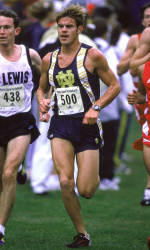 Shay was a fierce competitor on the cross country trails whose strong devotion to the team produced a gutsy performance that helped the Irish win the 2001 BIG EAST title (photo by Matt Cashore).
Shay was a fierce competitor on the cross country trails whose strong devotion to the team produced a gutsy performance that helped the Irish win the 2001 BIG EAST title (photo by Matt Cashore).
The finish produced the second cross country All-America honor of Shay’s career, along with his 12th-place finish in 1999. He also was a four-time All-American in the outdoor 10,000 meters – placing among the top-10 in 1999 (7th; 29:55), 2000 (7th; 30:54), ’01 (1st; 29:05) and ’02 (2nd; 28:32) – in addition to twice earning All-America honors in the indoor 5K, with matching times of 14:02 (good for 9th in ’01 and 6th in ’02).
One of Shay’s more impressive All-America finishes may have come at the 2001 NCAAs in Eugene, two days after winning the 10-K race. It originally appeared that Shay would not run in the second race for which he had qualified (the 5K) – but Piane encouraged his star runner to sleep on it and leave his options open. Shay ultimately decided to run and set a goal of breaking Dan Garrett’s 1988 school record (13:55). The pack adopted a slow pace early in the race and Shay shifted his focus to securing an All-America finish (typically top-8) – which he achieved (6th), in addition to the bonus of setting the school record (13:52).
Shay’s stellar career included winning nine BIG EAST titles: cross country in 1999; two in the indoor 3,000 (’99, ’02); two in the indoor 5K (’01, ’02); the 2000 outdoor 5K; and the outdoor 10K every year from 2000-02. In the later stages of his career at Notre Dame, Shay earned a spot in the 10,000-meter trials for the 2000 Olympic Games and impressively finished 10th (first among collegians) in that qualifying race. Years earlier as a freshman, he ran with the U.S. contingent at the 1998 World Junior Cross Country Championship in Morrakeck, Morocco, finishing 20th in a time of 24:20 (best among any non-African in the field).
The Shay children grew up in the heart of Michigan and established themselves as a hardworking group of distance runners, with several of the older and younger siblings joining Ryan as collegiate athletes. Shay’s pre-Notre Dame accomplishments included placing fourth in the 5-K race at the 1997 Junior Nationals (14:58), earning him an alternate spot for the Pan-Am Games that year.
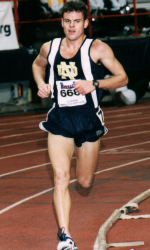 Shay came to Notre Dame as one of the middle children in a family of eight distance-running siblings.
Shay came to Notre Dame as one of the middle children in a family of eight distance-running siblings.
“Ryan was such a competitor. We used to joke that in Central Lake, they must have eaten rusty nails for breakfast, lunch and dinner,” says Watson. “He just had an incredible strength of character and toughness – it was very admirable. You don’t meet that type of person that often.”
Shay’s fellow Michigan native Brian Sell, who earned one of the spots on the 2007 Olympic marathon team, had a similar take on Shay’s personal fortitude. “Ryan was from the East Jordan area and, in Michigan, all the manhole covers are made by East Jordan Ironworks,” said Sell. “I always think of him every time I see one of those. He’s a tough guy from a tough area.”
When he first had the chance to qualify for the Olympic team (back in 2000), Shay couldn’t help but daydream about competing on the Olympic level. “The chance of being able to represent not only Notre Dame, but the U.S., in the Olympic Games was a big rush for me,” said Shay, following the 2000 trials. “It was kind of like a circus atmosphere.”
Later in his college career, Shay reflected on his growth over the years as a member of the Irish cross country and track-and-field programs. “At Notre Dame, I learned how hard one must work to reach an elite level of running,” he said. “I’ve learned the sacrifices that must be made to become a national champion. I wouldn’t trade being a part of it here at Notre Dame for anything.”
 Shay posted his first of nine All-America honors with a 12th-place finish at the 1999 NCAA cross country meet (photo by Matt Cashore).
Shay posted his first of nine All-America honors with a 12th-place finish at the 1999 NCAA cross country meet (photo by Matt Cashore).
As Piane copes with the all-too-early loss of one of Notre Dame’s all-time greats, he also will remember the “fire in the belly” that defined Shay’s approach to running: “Ryan was the most tenacious competitor I ever had the honor to coach. If we ever needed to pick up a point in the standings or a win, we could turn to Ryan Shay and he would deliver. He didn’t give anything away – that’s for sure.”
Watson – who says that the tragic news of Shay’s death “came out of nowhere” and hit him “like a ton of bricks,” was struck by Shay’s competitive intensity the first time he saw him run, while visiting Notre Dame on his official recruiting trip.
“Ryan knew one thing: run very fast and very hard,” says Watson. “After Notre Dame, he lived a very professional lifestyle: running twice a day, napping in the afternoon to recover, eating right. He did all the little things that you would expect from the consummate professional and made the most of his opportunities. He even was revolutionary in seeking sponsors beyond the basic shoe contract [Shay was sponsored by Saucony]. He had a deal with the EAS sports drink and had some other things in the works. He looked at things `outside the box,’ as a business person, and again I think he will end up being a trendsetter in that regard.”
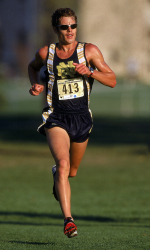 Shay – who often appeared at ease in his races, despite the brisk pace – will be remembered for more than simply his running dominance and competitive drive.
Shay – who often appeared at ease in his races, despite the brisk pace – will be remembered for more than simply his running dominance and competitive drive.
Watson’s prevailing thoughts about Shay continue to drift away from the tracks and trails. “Running was so important to Ryan that a lot of people don’t realize he also was very interested in academics,” says Watson “He loved to debate and talk philosophy, and he knew that Notre Dame was a place where he would be able to do that while being challenged academically.
“He also had a lot of qualities like he was one of your family members. He would do almost anything for you, like a brother. He had that strong personality, very opinionated and often stubborn. But, as part of that, he was so loyal and stood up for what he believed in. There were many times that he stood up for his teammates and his brothers. He would not back down from supporting the people he believed in.”
Shay is survived by his wife Alicia, parents Joe and Susan, and his seven siblings: Jodie, Casey, Sarah, Amie, and younger brothers Nate (who also was a distance runner at Notre Dame), Elliott and Stephan.






